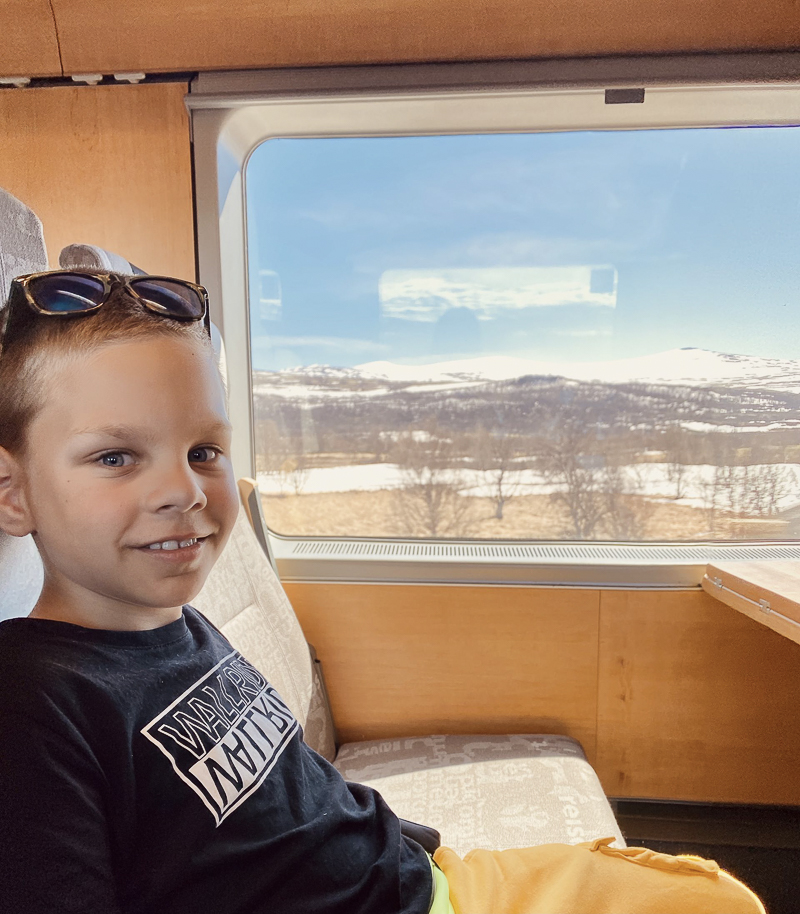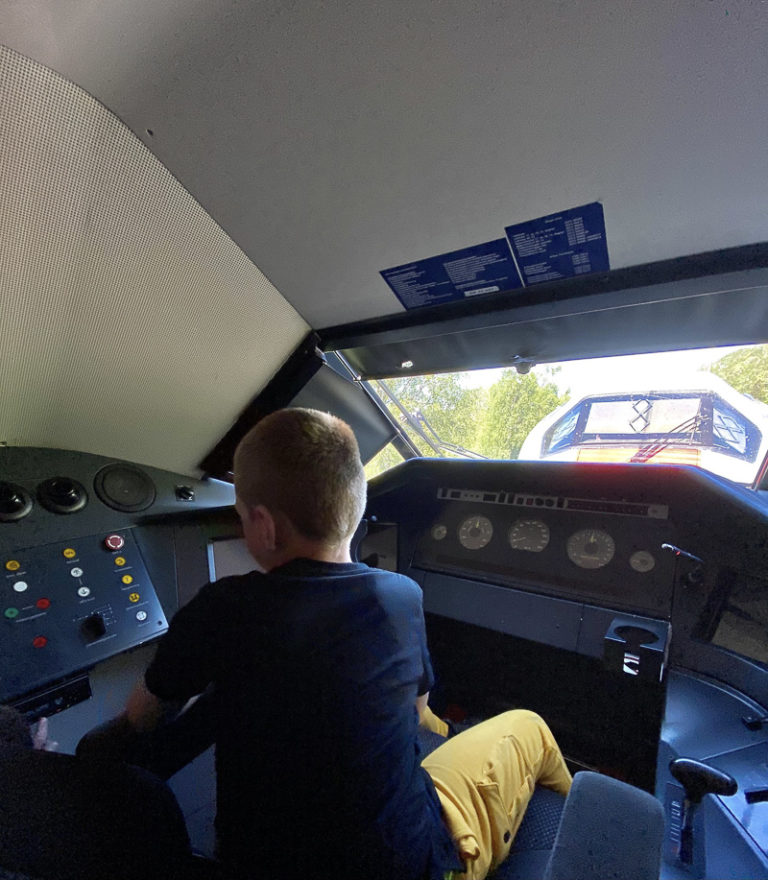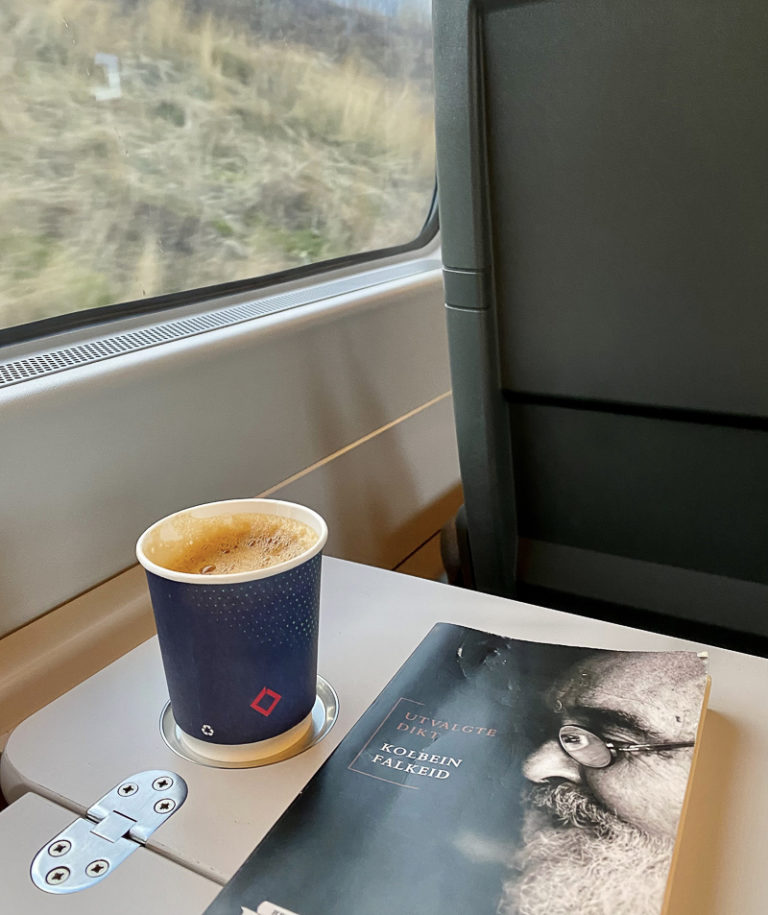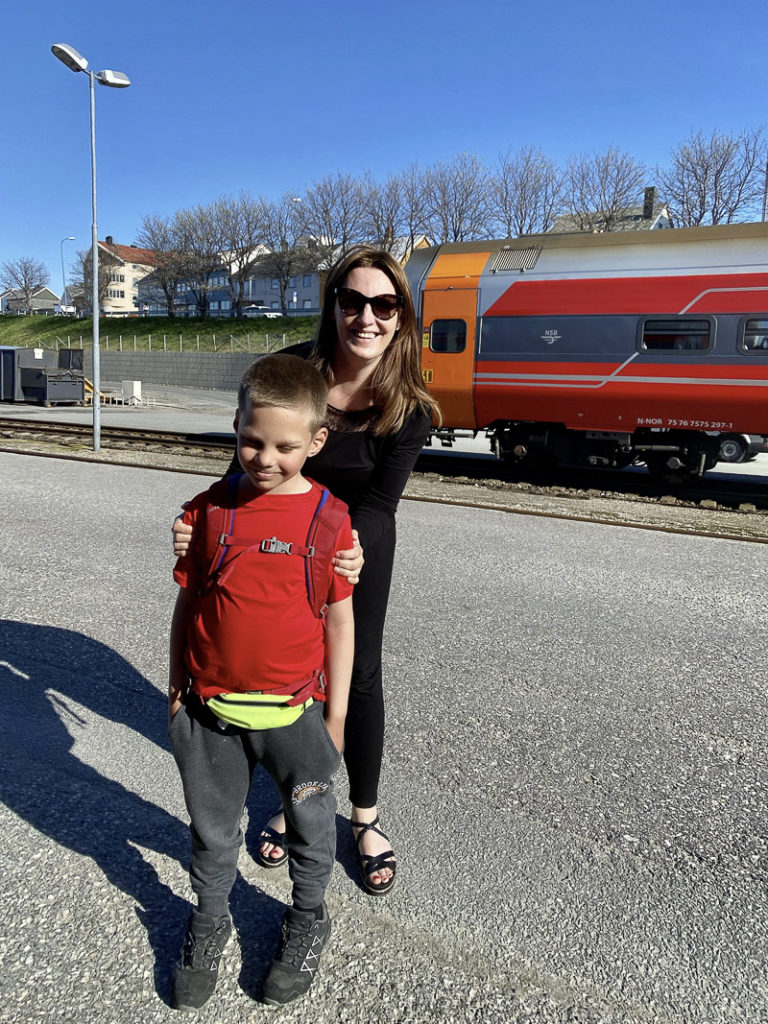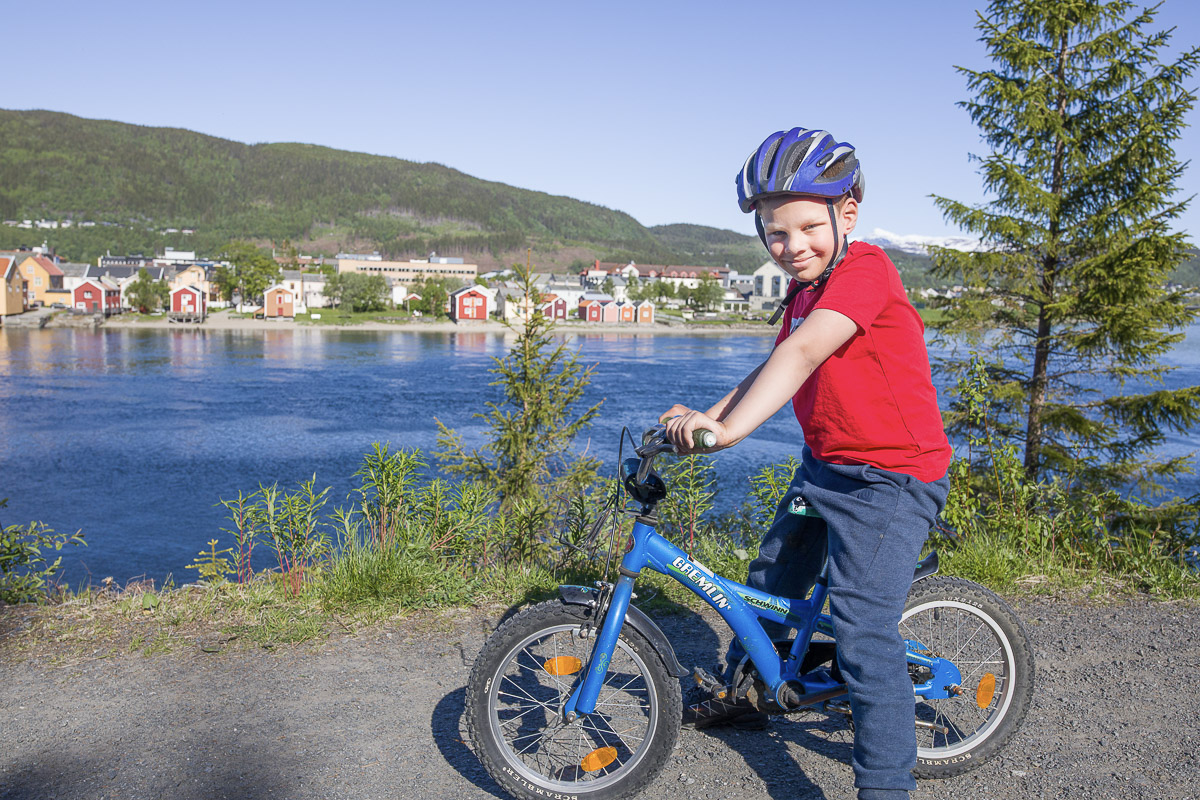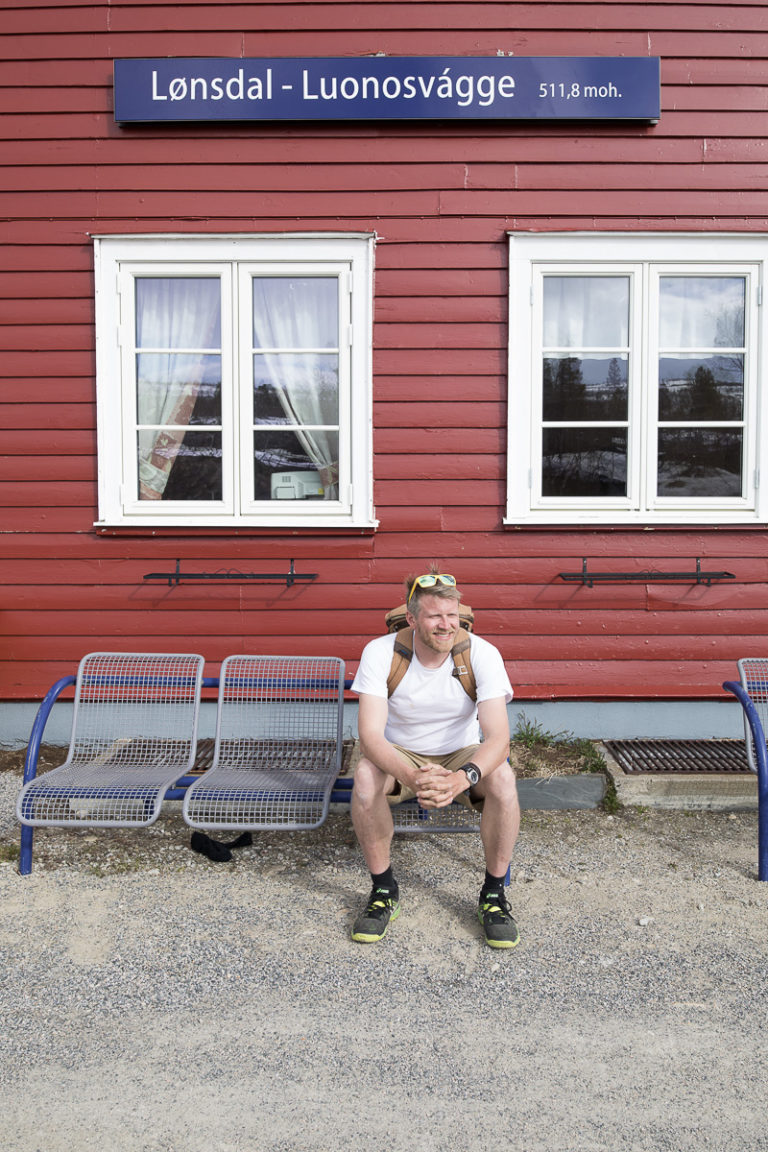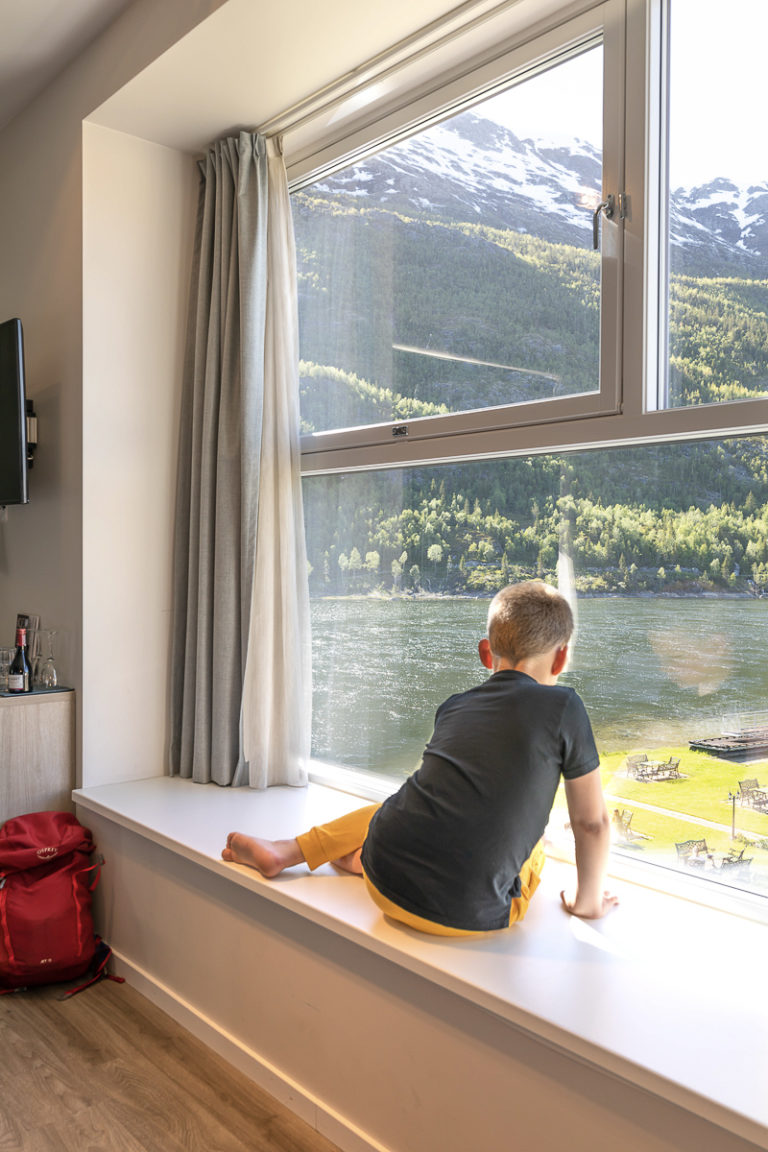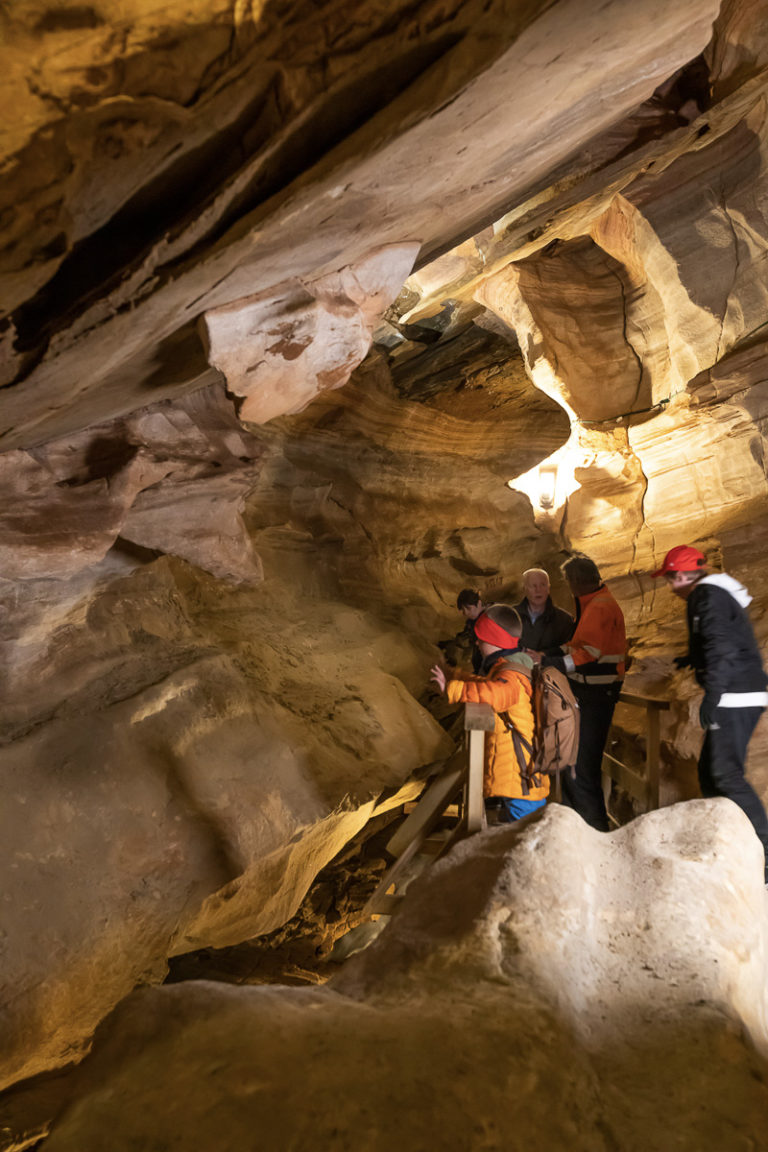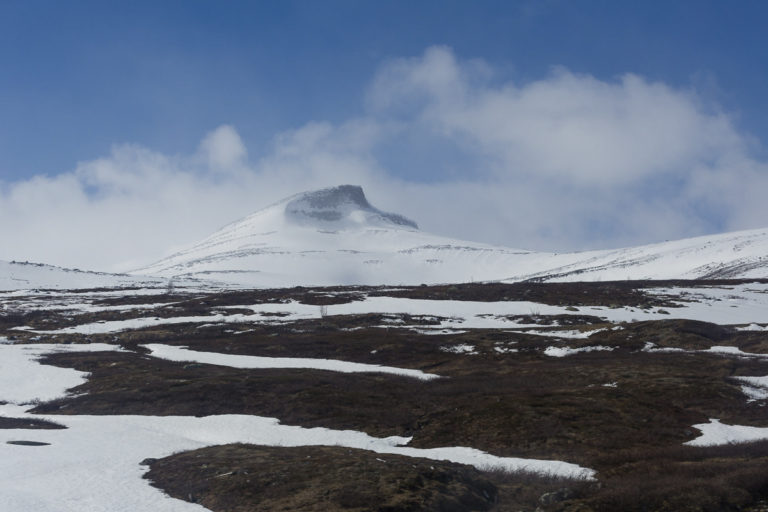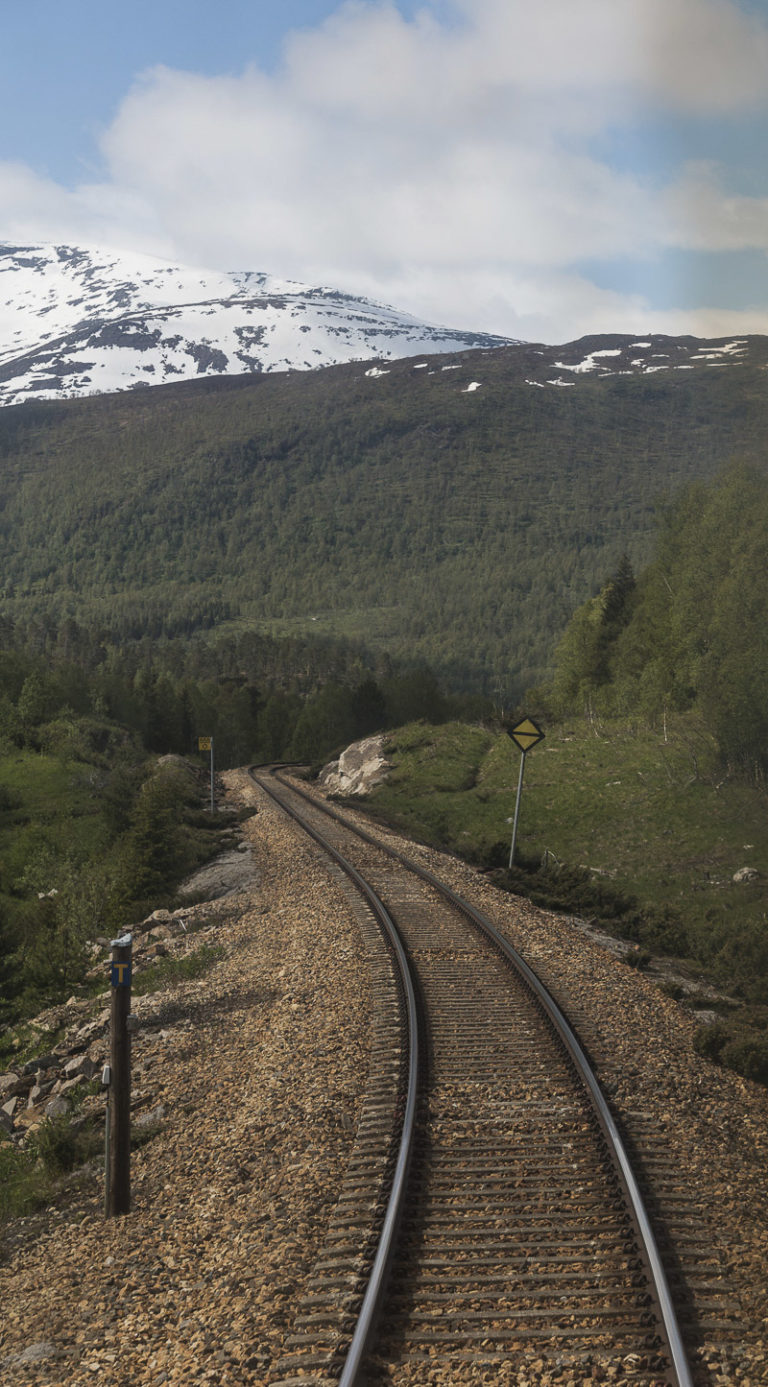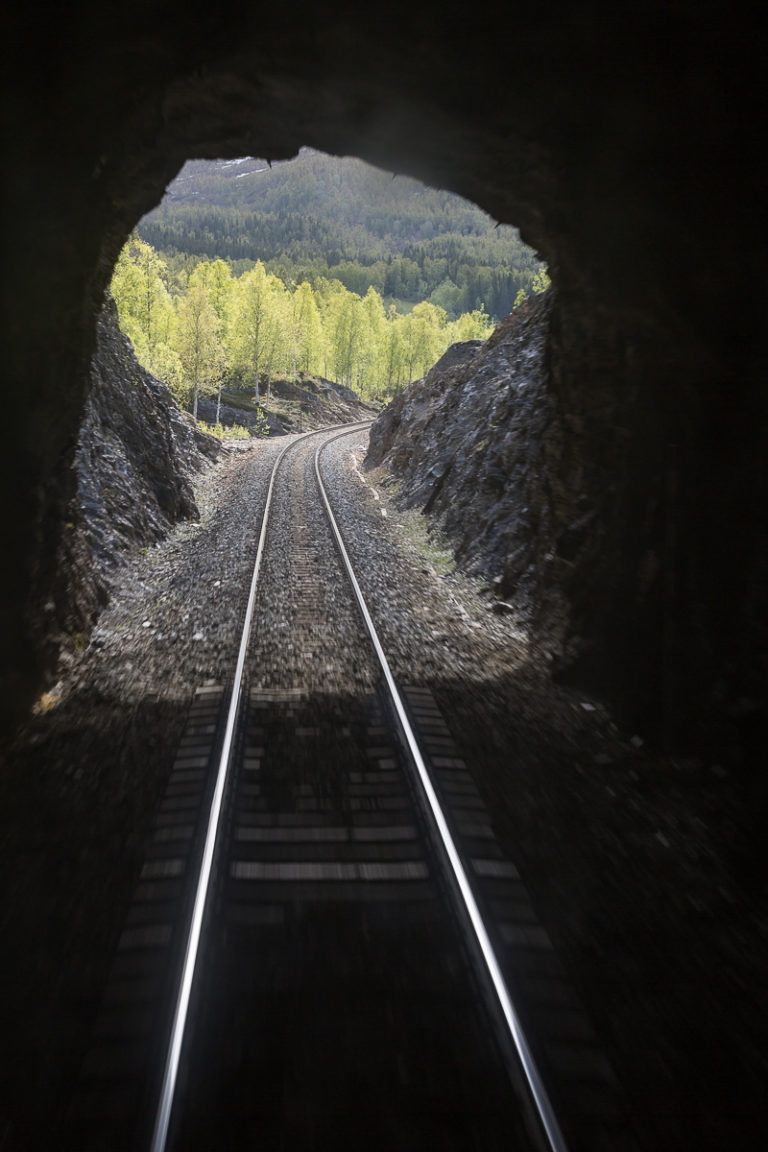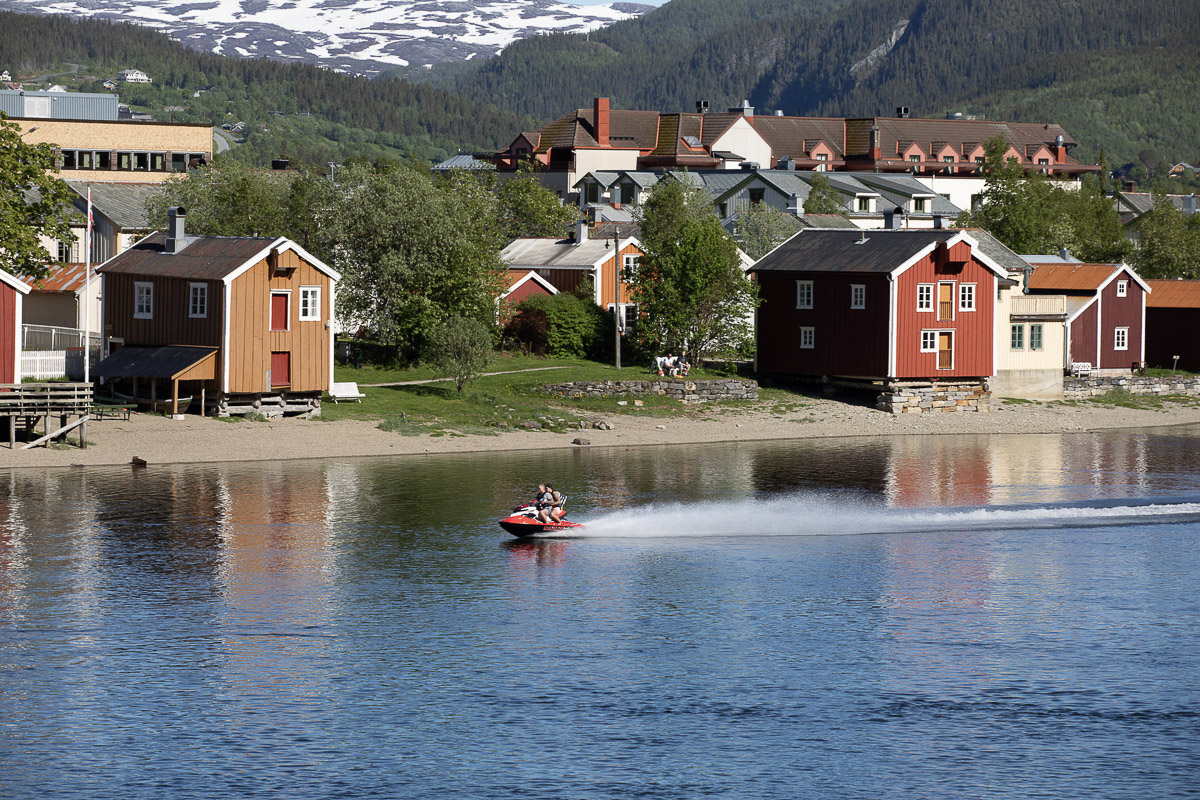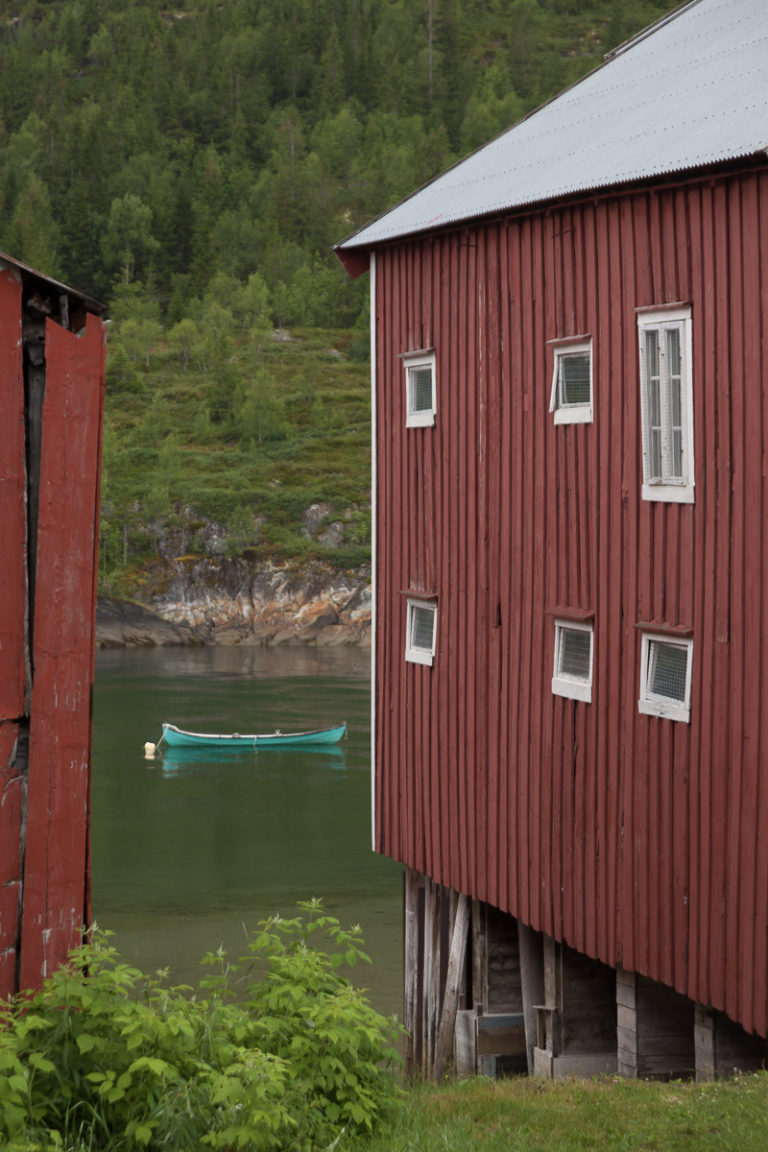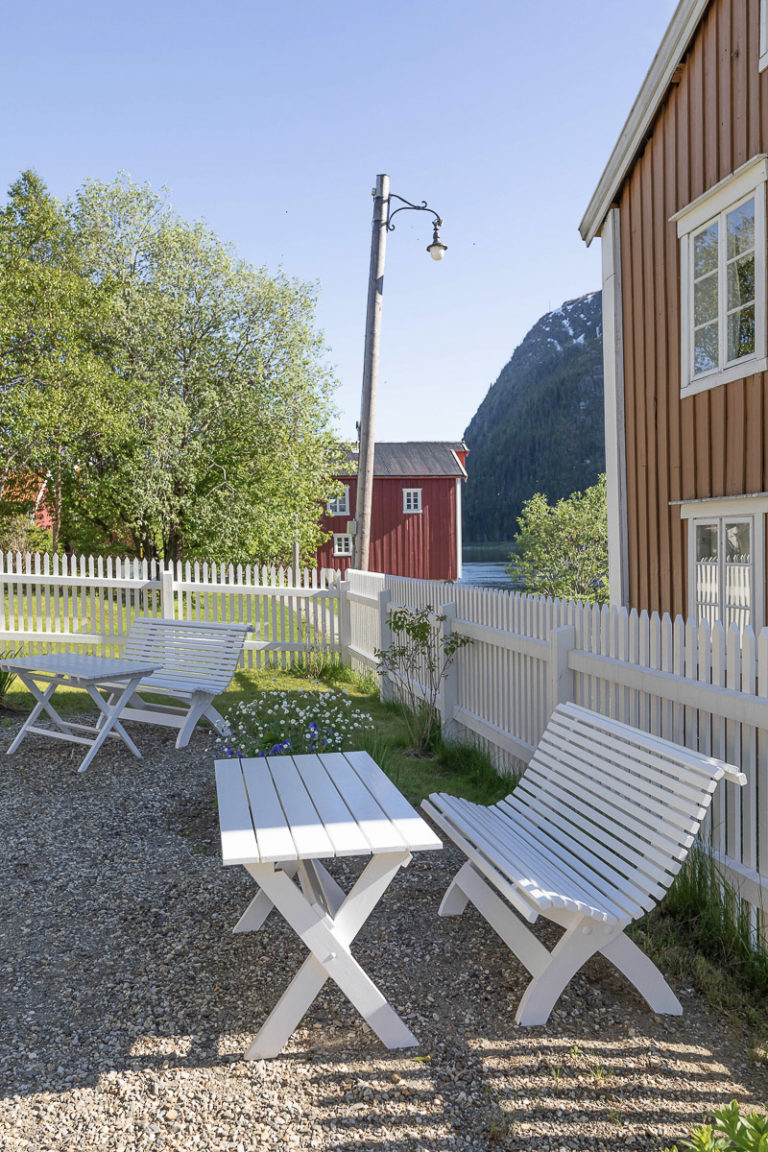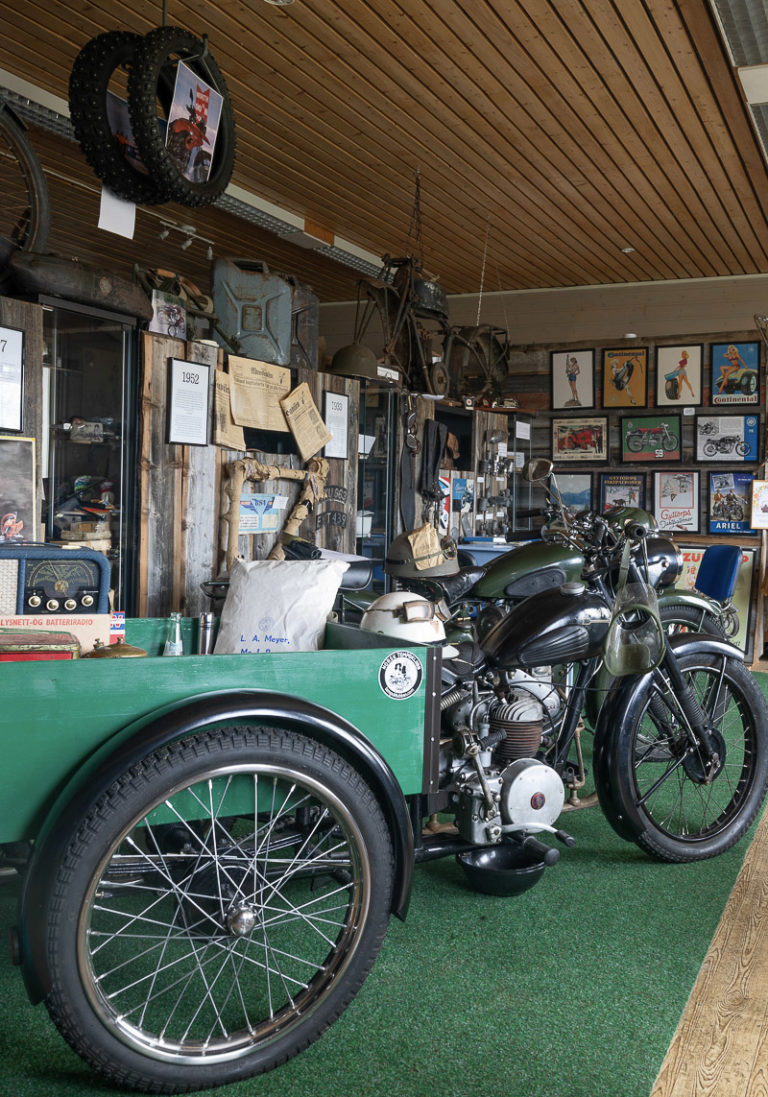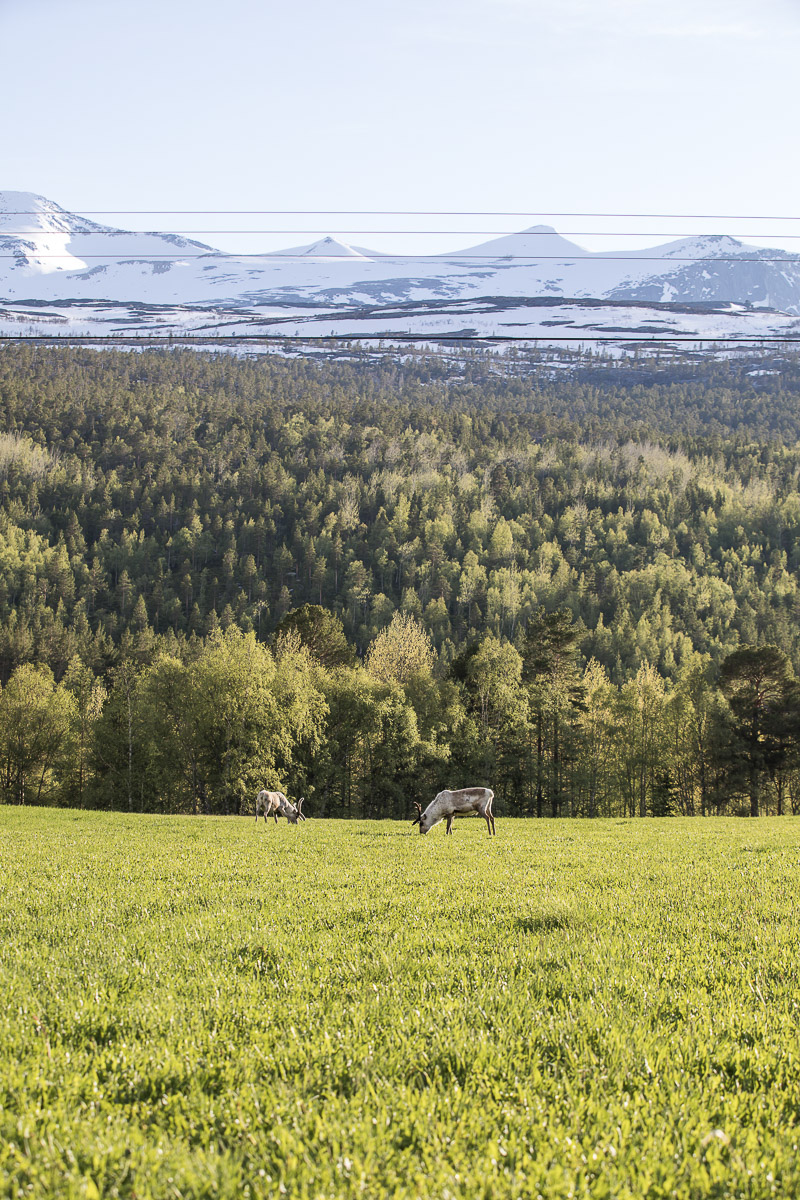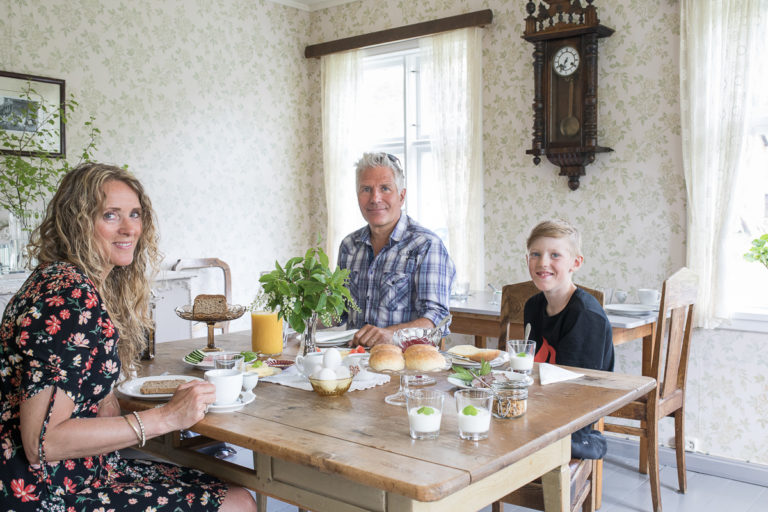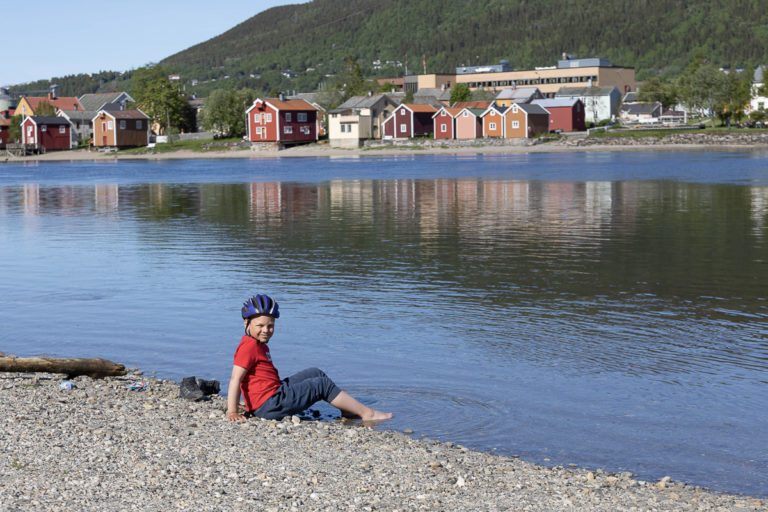The train carves its way through the changing landscape of Northern Norway. Let yourself relax, lay back in your seat, and be enriched by what you see between departure and arrival.
Watch the landscape change from the comfort of your seat as you travel through lush valleys, over the giant mountain of Saltfjellet, and into the borderland between north and south. Cross the Arctic Circle, which marks the changing of seasons from spring brightness to seductive summer nights. Sink into your train seat after safely stowing your luggage in place! An unforgettable holiday awaits as the train lurches forward. A welcoming journey has begun.
Travel north at a comfortable speed
It doesn’t matter where you board the train – in Trondheim or Bodø. What awaits you is nature in all its glory; wonderful and changing as the cultural landscape of Norway unfolds outside the windows of your coupe. Quaint and dramatic experiences await as we roll through Helgeland and Salten. Maybe you brought a book to read along the way? Anyone you want to write a letter to? Or share your journey with. Chatting about what you see and experience outside? There will be time to get better acquainted and make up for lost time.
Vy (formerly NSB): The Nordland Line is not only Norway’s longest stretch of rail. It has also been named one of the world’s most beautiful train journeys by Lonely Planet. This is a unique journey through natural and cultural landscapes. The Nordland Line was chosen for the Norwegian National Broadcasting Corporations slow-TV concept: The Nordland Line Minute by Minute in 2018.
SJ (which operates the railway line today): The Nordland Line serves over 200 000 inhabitants in the regions of Nordland and Trøndelag. The summer season is the most popular time for tourists. You can book your tickets online: SJ Nord.
I brought a little friend along as a travelling companion.
My inquisitive nephew joined me on this journey. Northern Norway is a strange place for a boy who grew up in Valdres. He has heard about this mysterious region on postcards sent by his aunt for many years. “Just think auntie, I am finally going to Northern Norway! Adam is a committed first-time traveller at eight years of age, with contagious zeal. Everything I heard about in the past comes to life. Arriving late for departure is also an experience in itself: We barely made it to the train on time this morning in Trondheim! We were having so much fun that we forgot the time. Once we got our breath back, we were able to enjoy the breakfast we bought at Hotel Britannia. The journey began as a dream, half asleep and slightly stunned at the same time. Huff! Yeah, it felt good leaning back in the train seat!
We became more exhilarated as things got active outside along the way
After catching our breath and knowing that we would be completely free the next nine hours as we reach the edge of the stormy sea, at the entrance to the infamous Vestfjorden. Our first event was photographing everything outside as the train stopped. This would become a natural habit on our journey. We peeked out every time the train stopped at a new station along the Nordland Line, every chance we could get. Our momentous journey was duly documented in photographs of us together below the railway station signs. Frozen moments sent immediately to grandma Sigrid, a native of Breivika in Salten (or Salta as the elders say). Proof that Adam was finally on track, entering the north of Norway, being 1/4 northerner as he is. Although we are travelling in our own country, the landscape is quite different from the flatlands where we live. A variety of adventures lie ahead.
The sun at midnight? Is that even possible?
“Huh? I don’t believe it.” Adam said, looking at me in amazement. Is auntie telling the truth? Or is she just kidding with me again? “Yes sir,” I said. The sun is up long into the night, some places even in the middle of the night in Northern Norway. He still doesn’t believe me. I smile as I recall the enchanting, bright summer nights of my childhood in Breivika. Travelling with a young lad who thinks he is already grown up involves some restlessness and at least a thousand questions. How many tunnels do we travel through on the Nordland Line? Before I reveal my lack of knowledge on that point, I distract him: Look at the waterfall! Look at that gorge; check out the old house, and look over there! So, when Adam gets restless again, I break out my compass app. I explain the cardinal points to him in our seats. The compass would be a fun game as the train swings to the east and west. A future gift idea was noted down; a real compass!
As we head farther and farther north, my inner compass tells me that we are on the right track
I feel like I am travelling backwards in time, back to my first journey on the Nordland Line. With my grandma Ragna from Lofoten. We left in the middle of the night, in winter. We were heading for Breivika, in Salten. Just on the other side of the fjord, Skjerstadfjorden, from Fauske. The memory of a conductor in a stately uniform and his brimmed cap emerges. He kindly led us to a small coupe where we would sleep for the night. Suitcases, the old ones without wheels, were dragged in and stowed below the three bunks.
Recognisable sounds evoke old travel memories
Memories of a soft, thick cotton nightgown and climbing the ladder after brushing your teeth. With my nose almost touching the ceiling, while grandma Ragna snored lightly in the bunk below, I was cradled to sleep by unfamiliar sounds. Rolling along, over Saltfjellet mountain, in a blanket of wind and snow. I tried to stay awake throughout the night, heading north, but I slumbered easily and woke up occasionally to the metallic sounds of the train brakes, or the light from the station platform that seeped through a crack in the curtain: I saw the snow falling in the glowing light of the lamps outside. Then suddenly, a stranger walked in during the night! She laid down in the empty bunk. People shared coupes back then; people you didn’t know. My grandmother slept soundly below me in the middle. I heard her soft snoring, which comforted me. I knew she was close. The journey brought a sense of excitement, an adventure into the unknown. The flashback is also a journey into the nooks and crannies of the mind, where grief also resides. Feeling the loss of those who have left before us.
Auntie! Are we in Northern Norway yet?
Adam was standing in the aisle to feel the train’s movements. Take out your phone! Look! We are a blue dot on the map, approaching a red line: The border to Nordland County. We watched carefully and cheered as our blue dot crossed the red line. We were not disturbing many people. Saturday is a quiet day on the train. The eight-year-old called his mom, Tove, at home in Valdres. She was born in Bodø: “I just got to Northern Norway” he said, looking at me inquisitively. “Were you my age when you travelled with great grandma? The aspect of time, more than thirty years, is like an eternity to a youngster who started counting his age with an iPhone 4. “Well, perhaps a year or two less. There have been many journeys by train since then, heading north. Train travel is my absolute favourite way of getting around.
We approach the town of Mosjøen through a landscape of lush forests.
Mosjøen is a charming town of wooden houses with a long history of café life. If you are travelling by car, definitely make a stop of the E6 highway to visit this wonderful place! You cannot see this lovely town from the highway! Mosjøen has many idyllic cafés and eateries like Sjøgata, a must-see for nostalgic tourists. There is a captivating, Instagram-friendly and historic petrol station from the time when the E6 ran through the town! If you are looking for a little more action, there is a via ferrata on the other side of the once-wild Vefsna River, otherwise home to wild salmon that flows past the row of old wooden piers before it feeds into Vefsnfjorden. If you venture out a little farther, a zip line awaits you on the mountainside at Øyfjellet. Huff, what a rush! Do you dare take the zip line twice? We did!
A historic wooden building made quite an impression
History is so visually present here; one quickly falls into notions of what life must have been like long ago. Below a train station that opened in 1940, close to the riverbank, you will find Fru Haugans, one of Norway’s most historic hotels. In operation since 1885, run by five generations of women. The hotel itself is even older. People have been seeking shelter for the night here since 1794. There is a museum area that shows you what the rooms looked lie back then. We have already booked our room for the journey home, heading south. We jump off the train quickly to get a picture of the train station before getting back on board.
Mo i Rana, the city on The Blue Highway, is evolving
The next step on our journey takes us to Mo i Rana; the railway takes us close to Vefsnfjorden (called Vaapstenvoene in Southern Sami) towards the former industrial town located on the slope down to the east side of Ranfjorden, where mountains and fjords unite. Mo i Rana boasts a rich and extensive industrial history with many human destinies crossing here, as well as a strong theatre tradition with varied productions on the stage of Nordland Theater. The city has been through a transformation in recent years offering many more exciting experiences for visitors and residents. The knowledge center is new, home to Helgeland Museum, Rana department.
We take a detour towards the coast and head underground
You can leave the Nordland Line at Mo i Rana Station and take a bus trip to reach the coast. To the outer edge of Helgeland. The Blue Highway continues from Mo as part of Europe Highway 12, farther west to Træna on the sea. The ferry to Træna sails across open sea on Trænfjorden. The ferry is technically part of the roadway grid which connects all the way to Petrozavodsk in Russia, through Sweden and Finland, heading east from Mo i Rana. There has been widespread cross-border trade in these regions for centuries. At Hemmavann, Swedish goods are available from a vintage bus, which is popular among the residents. Once upon a time, it was the Swedes who went to Mo i Rana to trade and exchange goods. A visual hint from those days can be seen in the oldest part of Meyergården, a traditional hotel that, like Fru Haugans, was annexed to a modern building. After our short stint here, we are looking forward to coming back and exploring the local caves outside the city, and following the Blue Highway to the coastal resort town of Nesna, to join the eagle safari and spend some time at Lille Syden, a charming little water park.
The terrain rises slowly as we head towards the borderlands
Our excitement rises as the train slowly climbs the valley of Dunderlandsdalen. We are now approaching the Arctic Circle: The midnight sun can only be seen north of this spot. As the train cuts its way through Saltfjellet mountain, I know we are rolling through a bygone era. The mighty valley runs through a land of waterfalls as it follows the curves of the Ranelva River. We roll over bridges that were built by hand, stone by stone, by tough Swedish rallere (i.e. navvy labourer). These bridges allow the Nordland Line to bring people across the deep gorges and abysses. We get a little squeamish from time to time as we exit a forest and suddenly see the train hanging in mid-air. We fly past old, abandoned hay barns that have been disintegrating for decades. Past abandoned railway stations and the farm of Ole Tobias Olsen, the proverbial father of the Nordland Line. It took three generations to build the railway line. Ahead of its time, this railway was an innovative idea and something worth fighting for. The locals called it Via Dolorosa, and we see why. Several generations of families from the region have been visiting the center of power to the south with unwavering intent, to voice their hopes and dreams about a railway line before the Nordland Line was finally adopted, and construction could begin.
What is the Arctic Circle?
There is a fierce history hiding behind these powerful nature experiences
Thanks to these unwavering heroes of the past, we can now sit back and watch nature unfold outside the train, all the way through the valley: Up the southeast slope of Saltfjellet mountain to the bare mountain plateau with its highest point at 680 meters above the North Sea. The mountain peak is a frontier for a number of species. The locals have a saying: spruce does not grow north of Rana. But. The Nordland Line, this beautiful stretch of rail, also has a dark chapter in the history of Norwegian transport. The dramatic backdrop is touching. Especially over Saltfjellet
The Motorcycle Museum and the Blood Road Museum tell us of much suffering
The Arctic Motorcycle Museum at Storforshei – north of Mo i Rana – gives us much insight into this dark history. Benny Sætermo, the owner of the museum, offers many artefacts from the war years. He manages to convey the stories that have been handed down orally by those who witnessed the Second World War. “Few places have seen so much agony and tears as the Nordland Line,” he said. His collection of artefacts takes visitors close to the fierce history of the Polar Line, as it was called back then. We cannot continue without telling a bit of this story. It is difficult not to remain untouched by the stories. We find some comfort in all this suffering, seeing the compassion demonstrated by the inhabitants of Saltdalen. The Blood Road Museum at Rognan shows us the harsh reality of what is now past history. Around 30 000 prisoners of war are estimated to have carried out forced labour working on the Nordland Line.
Traces of humanity made an impression
It is comforting to learn that several inhabitants of Saltdalen helped some prisoners escape. Many farms in the area still keep the small gifts that were thrown over the barbed wire fences by the starving prisoners, in gratitude over the food that was smuggled to them by the locals. Like small chests made from whatever materials they had at hand. Some of the prisoners survived because they found help from the locals who knew the mountainous and wild, magnificent landscape. Many of them returned many years later. But let’s return to some happy thoughts on our journey through magnificent natural surroundings. Sigrid remembers the gratitude shown to the locals by many of the prisoners. She also remembers their desperation, and sheer despair upon reuniting in places where inhumane war crimes took place. “It is a horrible story that still lives among us, even though I was born in 1957,” she said. Like many in Salten, she grew up with the stories and depictions from a time we can only hope to have learned from.
The north has a strong force of attraction
Many people love the feeling of crossing the Arctic Circle. “Many people propose to their partner in the parking lot,” Benny said. For many, the Arctic Circle is an important border to cross: It is considered the gateway to the far north. You can go online and see the historic moment when the Arctic Circle was first crossed by train passengers on board a train. A ribbon was cut with a traditional Norwegian sheath knife: Silk ribbons and scissors are not suited to a railway line running through this harsh climate. If we draw a line running straight out to the coast, the Arctic Circle crosses approximately where Trænstaven mountain out at sea is covered by the island mountain of Hestmona. And, in the blink of an eye, you are in the realm of the midnight sun! It may be a cliche, but cliches are fun for good reasons! The landscape gets wilder once we pass Saltfjellet.
The landscape gets wilder once we pass Saltfjellet
There is no line drawn on the ground that shows where the Arctic Circle is crossed, but the landscape of the Saltfjellet does change soon after crossing, on our way off the mountain plateau. We heard the conductor announce Lønsdal Station. A station of opportunities. We disembarked here a while, in the heart of the mountains. Fantastic! There are many hiking opportunities in the area. Just thinking about the descent reminds me that I need to hold onto my seat to hold my breath. Just before the descent, be sure to look!
Junkerdalsura is a dramatic river gorge in the east.
One of my first memories in life is driving on the old local Graddisveien road, national highway 77, over Kjernfellet mountain, which is now a bicycle and hiking route. “It goes without saying that you should not look down when we drove around a curve with the cliffs below. If you looked down you could see right into the gorge far below us! We drove partly on the old road that was upgraded in 1973. The road was so narrow that we had to stop for oncoming cars at the laybys. “Sigrid asked if I remembered the signs with the letter M on them, when we spoke on the phone. She continued, “but that was nothing special back then; the roads around Saltdalen were like that everywhere,” she claimed. Anyway, descending from Saltfjellet you see a mighty panorama ahead, my absolute favourite stretch of the Nordland Line.
Brake! Join me for a little flashback?
But, let’s pause a moment before we whizz down towards Storjord along the steep mountainside: There was a time when Lønsdal Station was the last station on the Nordland Line. In the past, the fishermen would send their catch here in trucks so the train could transport their product to the south. Part of the driving force of the people behind the Nordland Line was that the fishermen would benefit more from selling their fish farther south and in Europe. Frozen fish seemed to pay better prices than stockfish. From here, the old Rallarveien road down to Storjord is being repaired and upgraded. For those who like to cycle, you can easily make your way from Storjord to Rognan Station on flat ground. Or do as we do. Rent bikes at the National Park Center, to explore the marked trails that take us across lofty suspension bridges that take us across Junkerdalselva River and Lønselva River. The two rivers meet at Storjord and form Saltdal River. Here we could study the kettle hole just beyond the small, charming Storjord Hotel.
We agreed to some chocolate and fresh coffee
The friendly lady running the café, Yvonne, came over and offered us some freshly brewed coffee and chocolate. We indulged in a little luxury; what we used to call first class travel in the old days. My aunt drinks so much coffee in a nine-hour trip that it quickly pays off anyway. If you travel by plus-ticket, you get free, unlimited and invigorating beverages. A young lad is always happy to be offered a tasty piece of chocolate.
Then we hear Fauske Station being announced over the loudspeaker
The compass app is working intensely as we turn west, from Fauske farther on towards Vestfjorden, and towards the end station in Bodø. Fauske, by the way, is still an important hub on the way north, by bus. Apparently, a sea of people flocked here in November 1958 when the stretch of the Nordland Line was completed from Røkland to Fauske. Even though this stretch of track is only 40 kilometers long, there was some real labour needed to complete this challenging stretch of rail.
Nostalgia hasn’t stood still
There is a trace of history on the station platform: The Fauske railway café. Some call it an institution. The kind of place people might take for granted these days because it has always been there. We bought something to eat at the cafe and brought it to our table on ancient trays. We were served and dispatched by very friendly staff. Many hungry people have passed through these doors waiting for a ride to homes or destinations they looked forward to reaching.
We are getting closer and closer, sleeper by sleeper.
The railway line runs alongside the wide Skjerstadfjord. We pass old, well-kept houses in a familiar Northern Norway style of architecture, and pass dilapidated old homesteads that look like they need a hug. If you travel off-season, before the leaves fall in the autumn or after they fall, you get the best views! Once we pass Tverlandet, out near Saltstraumen, the mountains of Børvasstindene stretch to the heavens on the other side of Saltfjorden.
We pack up and get ready as our train approaches the end station
The sky is clear today, and I am so excited to see Adam’s reaction when, later in the evening, he sees the midnight sun before he goes to bed. The first major destination of our journey is approaching: the final station on the Nordland Line: Bodø, on the threshold of Vestfjorden. Travelling slowly, by train, feels so right. I read somewhere that an elderly woman loved to remain at the airport a few hours waiting for her soul to follow. It feels as if it has been with us the whole time! How wonderful it is to travel by rail, I think to myself, as we listen to Moddi: “A hundred miles is not far in a railway carriage.”
We are finally at the end of our journey
Hurrah! We made it to Bodø! A pleasant conductor who has watched us jump on and off at the stations along the way, kindly asked me if we wanted to be immortalised together in a photo. How nice it is to have a picture of the two of us together! Such acts of kindness made us as happy as the clear northern night seems to be. We arrived at the end station of the Nordland Line, which opened in 1962 with flags flying, decorations and cheers from the attendees. We can now reach the county capital of Nordland by train, in ease and comfort. Enriched by everything that happened between our departure and arrival. Now that our trip is over, I wish it would continue. We leave in our tracks a journey full of good conversation, many questions, explanations and – for me – a new understanding of what you can learn from the many different apps on a cell phone. Our adventure, this Momentous Journey, will continue when we leave Bodø. But first, we need to take some pictures, ecstatic as we stand in front of the sign at Bodø Station.
Ofte stilte spørsmål
The Nordland railway runs from Trondheim to Bodø. Earlier, one considered it to run from Hell (just north east of Trondheim), where the Meråker Railway into Sweden branches off. The last lap, from Fauske to Bodø, was earlier considered a side track. This is because of long term plans to extend the Nordland line to Narvik, Harstad and Tromsø. And even beyond. However, it hasn’t materalised so far.
The whole length Trondheim-Bodø is 729 km/453 miles. Trondheim-Mosjøen is 406 km/252 miles. Trondheim-Mo i Rana is 498 km/309 km.
According to www.vy.no, the day train Trondheim – Bodø takes 9 hours and 48 minutes. The night trains takes 9 hours and 50 minutes. Mosjøen-Bodø varies from 4 hours and 1 minute to 4 hours and 28 minutes. Trondheim – Mo i Rana takes
The Nordland Railway stops in Bodø. If you want to travel further north, there is a bus from Bodø/Fauske til Narvik. From Narvik you can take a train to Kiruna, Luleå and Stockholm in Sweden. There is also a bus from Narvik to Bardufoss/Finnsnes/Tromsø. Kirkenes on the Russian border is also possible to reach some days of the week, but it requires two overnights. There is also a bus going on the Bognes-Lødingen ferry (before Narvik) connecting with Harstad and the Vesterålen Islands. Planning is best done by help of the website EnTur.
Big question! The dream to build a railway all through Norway is old, notably the first railway comittee was founded in Tromsø in 1872. The railway reached Fauske in 1958, and to Bodø in 1962. Calculations conclude that an extension further north is not profitable. The environment, road safety and the need to export fish faster are, hower, given as reasons to still do it.
The oldest part of the Nordland Railway is the line from Trondheim to Hell (!), a part of the Trondheim-Östersund (Sweden) line, opening in 1881. In 1902-05, the railway was extended north through the Innherred area past Levanger and Steinkjer to Sunnan at the end of Lake Snåsavatn. Next hop was Grong in the Namdalen valley, all still well south of Northern Norway, in 1929. From now on, however, work speeded up. At the German attack in April 1940, the leg to Mosjøen was about to be opened. During WWII, the German spent many rescources, along with employing slave labour from Yugoslavia and the Soviet Union, to build further north. An estimated 2000 prisoners of war died from exhaustion, cold or hunger, or were shot. By the end of the war in 1945, the railway had been extended to Dunderland on the northern slope of the Saltfjellet range. After WWII the work continued, reaching Fauske in 1958. Finally, what was seen as a branch line to Bodø, was added in 1962.
The night train is definitely a big time saver. You can board the train late at night, and sleep your way north or south for ten hours. When reaching Bodø or Trondheim, the day has just begun. This article is, however, all about the day train, a travel through the landscape in a humain speed. Anyone appeciating beautiful landscapes and local life should try the day train, at least one of the directions.
We strongly recommend to prebook at all times. This is especially true around holidays like Christmas, Easter and the bank holiday week-ends in May/June. Also the beginning and end of the summer school holiday is very busy. Week-days like Friday and Sunday are also busy. It is less busy in the week-days away from the holidays are less busy. Book at sj.no.
